
The necropolis of Draʻ Abu el-Naga' is located on the West Bank of the Nile at Thebes, Egypt, just by the entrance of the dry bay that leads up to Deir el-Bahari and north of the necropolis of el-Assasif. The necropolis is located near the Valley of the Kings.

The necropolis of Sheikh Abd el-Qurna is located on the West Bank at Thebes in Upper Egypt. It is part of the archaeological area of Deir el-Bahari, and named after the domed tomb of the local saint. This is the most frequently visited cemetery on the Theban west bank, with the largest concentration of private tombs.

The necropolis of El-Khokha is located on the west bank of the river Nile at Thebes, Egypt. The necropolis is surrounds a hill and has five Old Kingdom tombs and over 50 tombs from the 18th, 19th and 20th dynasties as well as some from the First Intermediate Period and the Late Period.

The ancient Egyptian noble Pabasa was chief steward of the God's Wife of Amun Nitocris I during the Saite Period. He is buried in tomb TT279, which is located in the El-Assasif, part of the Theban Necropolis, near Thebes.
The ancient Egyptian official named Menna carried a number of titles associated with the agricultural estates of the temple of Karnak and the king. Information about Menna comes primarily from his richly decorated tomb in the necropolis of Sheikh Abd al-Qurna at Thebes. Though his tomb has traditionally been dated to the reign of Thutmose IV, stylistic analysis of the decoration places the majority of construction and decoration of the tomb to the reign of Amenhotep III.
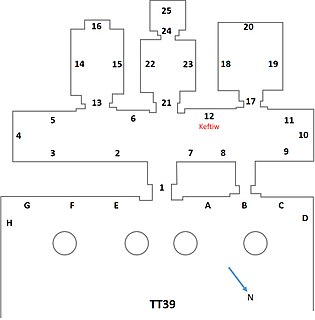
The Theban Tomb TT39 is located in El-Khokha, part of the Theban Necropolis, on the west bank of the Nile, opposite to Luxor. It is the burial place of the ancient Egyptian official, Puimre.
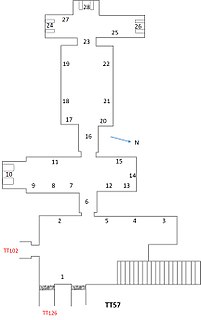
The Theban Tomb TT57 is located in Sheikh Abd el-Qurna. It forms part of the Theban Necropolis, situated on the west bank of the Nile opposite Luxor. The tomb is the burial place of the ancient Egyptian official Khaemhat, who was royal scribe and overseer of double granary, during the reign Amenhotep III. The relief decoration of the tomb is regarded as the best of New Kingdom art.

Mery was a High Priest of Amun from the time of Amenhotep II.
Nebwenenef was High Priest of Amun at the beginning of the reign of Ramesses II during the 19th Dynasty. Prior to that, Nebwenenef had served as High Priest of Anhur and High Priest of Hathor during the reign of Seti I and possibly even earlier.

The Theban Tomb TT32 is located in El-Khokha, part of the Theban Necropolis, on the west bank of the Nile, opposite to Luxor. It is the burial place of the ancient Egyptian official, Djehutymose.
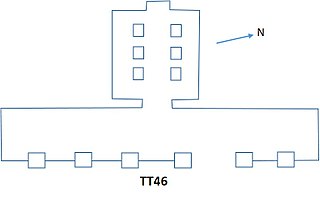
The Theban Tomb TT46 is located in Sheikh Abd el-Qurna. It forms part of the Theban Necropolis, situated on the west bank of the Nile opposite Luxor.
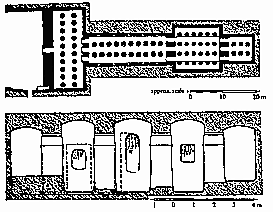
The Theban Tomb TT48 is located in El-Khokha, part of the Theban Necropolis, on the west bank of the Nile, opposite to Luxor. TT48 was the burial place of the ancient Egyptian named Amenemhat called Surer, who was a Chief Steward, At the head of the King, Overseer of the Cattle of Amun. Amenemhat called Surer dates to the time of Amenhotep III from the middle of the Eighteenth Dynasty of Egypt. He was a son of Ith-taui, who was an overseer of the cattle of Amun and the lady Mut-tuy.

The Theban Tomb TT58 is located in Sheikh Abd el-Qurna, part of the Theban Necropolis, on the west bank of the Nile, opposite to Luxor. The tomb was originally carved for a courtier dating to the time of Amenhotep III and later usurped during the Ramesside period.

Tomb TT189 is located in the necropolis of El-Assasif in Thebes, Egypt. It contains the sepulchre of Nakhtdjehuty, who was an overseer of the carpenters of the northern lake of the god Amun and the head of the goldworkers in the Estate of Amun during the 19th Dynasty reign of Ramesses II. Nakhtdjehuty's tomb is part of the TT192 tomb complex.

Tomb TT194, located in the necropolis of El-Assasif in Thebes, Egypt, is the tomb of Thutemhab (Djehutyemhab), who was an overseer of the marshland-dwellers of the Estate of Amun and a scribe in the temple of Amun during the Nineteenth Dynasty of Egypt. Thutemhab's tomb is part of the TT192 tomb complex.
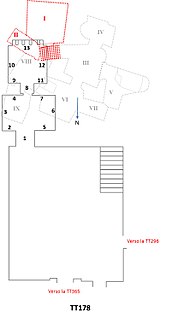
The Theban Tomb TT178 is located in El-Khokha, part of the Theban Necropolis, on the west bank of the Nile, opposite to Luxor.
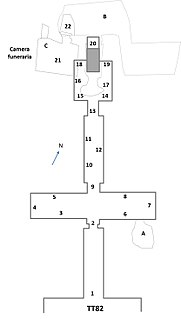
The Theban Tomb TT82 is located in Sheikh Abd el-Qurna, part of the Theban Necropolis, on the west bank of the Nile, opposite to Luxor. It is the burial place of the ancient Egyptian official Amenemhat, who was a counter of the grain of Amun and the steward of the vizier Useramen. Amenemhat dates to the Eighteenth Dynasty of Egypt, from the time of Tuthmosis III. As the scribe to the vizier Useramen Amenemhat documents the work in Thebes up to ca year 28. This includes the withdrawal of silver, precious stines and more form the treasury and the manufacture of a number of statues made from silver, bronze and ebony. He also mentions the creation of a large lake near Thebes surrounded by trees and work on the royal tomb.

Tomb TT187, located in the necropolis of El-Khokha in Thebes, Egypt, is the tomb of a wab-priest of Amun named Pakhihet.

The Theban Tomb TT385 is located in Sheikh Abd el-Qurna, part of the Theban Necropolis, on the west bank of the Nile, opposite Luxor. It is the burial place of the ancient Egyptian Hunefer (Haunefer), who was a Mayor of the Southern City (Thebes) during the reign of Ramesses II in the Nineteenth Dynasty.

Pedubast was an ancient Egyptian official during the 26th Dynasty. He is so far only known from his burial, found within the larger and earlier tomb complex of the mayor of Thebes Karabasken (TT391), located at South El-Assasif within the Theban Necropolis, in Upper Egypt.
Pedubast's burial was found in 2015 and announced shortly after. He was most likely the grandson of the well known chief steward of the God's Wife Pabasa who was buried in another large funerary complex at Thebes (TT279). Pedubast was overseer of Upper Egypt and chief steward of the God's Wife; in the latter position he managed the estates of the God's Wife of Amun, the leading religious figure in southern Egypt at the time. Pedubast only reinscribed some parts of the burial chapel of Karabasken. It seems that he was only for a short time in office having not enough time to build an own monumental tomb. The newly decorated parts include a door frame and a sun hymn. Fragments of his coffin were found too.


















